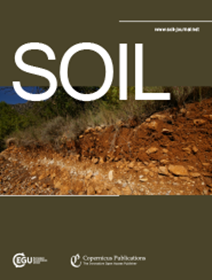Microbial carbon use for incorporating biomass phosphorus drives CO2 emission in phosphorus-supplied subtropical forest soils
IF 4.3
2区 农林科学
Q1 SOIL SCIENCE
引用次数: 0
Abstract
Abstract. Subtropical forests store significant amounts of soil organic carbon (SOC) and are important in the global C cycle. Current understandings based on controlled experiments indicate that phosphorus (P) availability promotes SOC decomposition by alleviating microbial P limitation or rendering SOC available for microbial decomposition. While no alternative mechanism is currently known, it is uncertain if this mechanism holds across soils or P supply levels at the field scale. We formulated an alternative mechanism for acidic subtropical forest soils where organic C (OC) is bound to iron (Fe). Our hypothesis proposed that P supply would promote Fe-bound P formation and desorption of OC previously bound to Fe, and the microbial utilization of the desorbed OC for P-cycling contributes significantly to CO2 emission. We tested our hypotheses by utilizing a forest P addition platform to explore C-dynamics, its regulators, and utilization across four P supply levels: 0, 25, 50, and 100 kg P ha-1 yr-1 (Con, P1, P2, and P3, respectively) for one year. Phosphorus supply significantly increased the periodic and cumulative dissolved OC (DOC) concentration, especially in P3, and was associated with increased iron (Fe)-bound P formation. With increased DOC following P addition, microbial biomass P (MBP) significantly increased, while MBC remained unchanged. The significantly positive relationship between MBP:MBC ratio and DOC, significant increase in MBP and carbon dioxide (CO2) emission with P addition, and the reduction in CO2 emission with increasing MBC:MBP ratio (0–10 cm) supports our results that the desorbed-C alleviated microbial C-limitation induced during P-cycling, particularly, MBP incorporation, to drive CO2 emission. Structural equation modeling and multivariate analyses projected MBP as a critical factor inducing CO2 emission. Besides, insignificant alterations in the relative abundance of C-degrading functional genes and reductions in P- and C-degrading enzyme activity indicated the sufficiency of desorbed OC for microbial use without further SOC degradation. Our study provides an alternative mechanism of P's impact on soil C-cycling processes in acidic subtropical forest soils vital for constraining process-based C models.在磷供应的亚热带森林土壤中,微生物利用碳吸收生物量磷驱动二氧化碳排放
摘要。亚热带森林储存了大量的土壤有机碳(SOC),在全球碳循环中具有重要意义。目前基于对照实验的认识表明,磷(P)有效性通过减轻微生物P限制或使有机碳可用于微生物分解来促进有机碳分解。虽然目前还不知道其他机制,但不确定这种机制是否适用于整个土壤或在田间规模上的磷供应水平。在亚热带酸性森林土壤中,有机碳(OC)与铁(Fe)结合形成了另一种机制。我们的假设认为,P的供应会促进铁结合的P的形成和先前与Fe结合的OC的解吸,而微生物利用解吸后的OC进行P循环对CO2排放有重要贡献。我们利用森林磷添加平台来验证我们的假设,以探索c -动力学,其调节因子和四个磷供应水平的利用率:0,25,50和100 kg P ha-1年-1(分别为Con, P1, P2和P3)一年。磷的供应显著增加了周期和累积溶解OC (DOC)浓度,特别是在P3,并与铁(Fe)结合的P形成增加有关。随着添加磷后DOC的增加,微生物生物量P (MBP)显著增加,而MBC保持不变。MBP:MBC比值与DOC呈显著正相关,MBP和CO2排放量随P的增加而显著增加,CO2排放量随MBC:MBP比值(0-10 cm)的增加而减少,这支持了解吸c缓解了P循环过程中引起的微生物c限制,特别是MBP的掺入,从而驱动CO2排放。结构方程模型和多变量分析预测MBP是诱导CO2排放的关键因素。此外,c -降解功能基因的相对丰度和P-和c -降解酶活性的显著变化表明,解吸的OC足够供微生物利用,而不会进一步降解有机碳。我们的研究提供了磷对亚热带酸性森林土壤碳循环过程影响的另一种机制,这对约束基于过程的碳模型至关重要。
本文章由计算机程序翻译,如有差异,请以英文原文为准。
求助全文
约1分钟内获得全文
求助全文
来源期刊

Soil
Agricultural and Biological Sciences-Soil Science
CiteScore
10.80
自引率
2.90%
发文量
44
审稿时长
30 weeks
期刊介绍:
SOIL is an international scientific journal dedicated to the publication and discussion of high-quality research in the field of soil system sciences.
SOIL is at the interface between the atmosphere, lithosphere, hydrosphere, and biosphere. SOIL publishes scientific research that contributes to understanding the soil system and its interaction with humans and the entire Earth system. The scope of the journal includes all topics that fall within the study of soil science as a discipline, with an emphasis on studies that integrate soil science with other sciences (hydrology, agronomy, socio-economics, health sciences, atmospheric sciences, etc.).
 求助内容:
求助内容: 应助结果提醒方式:
应助结果提醒方式:


